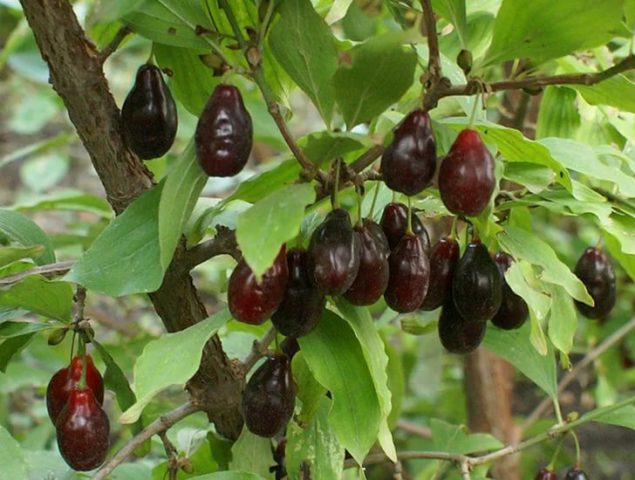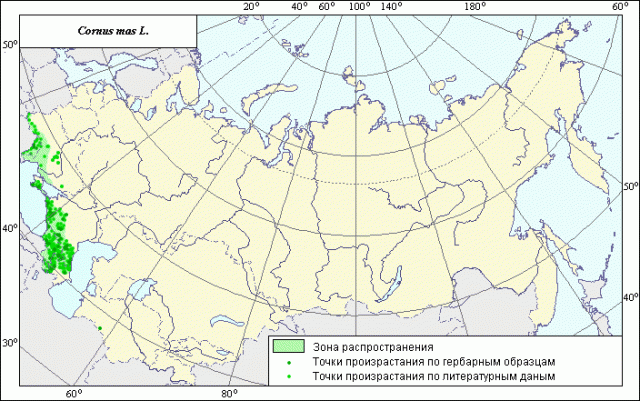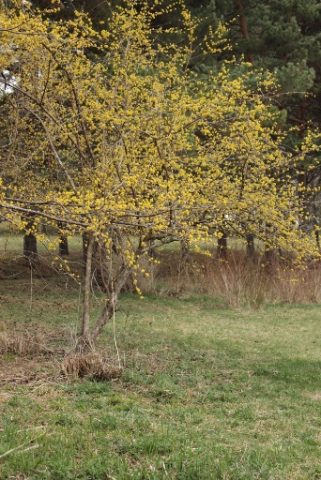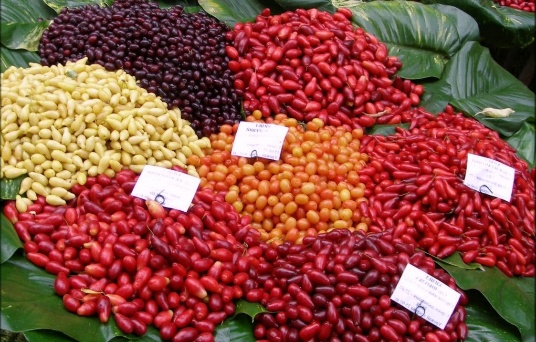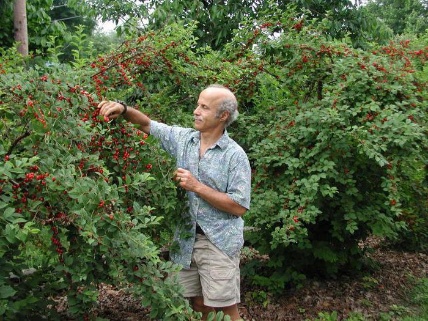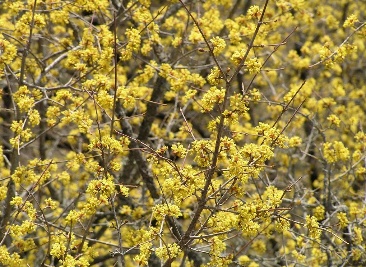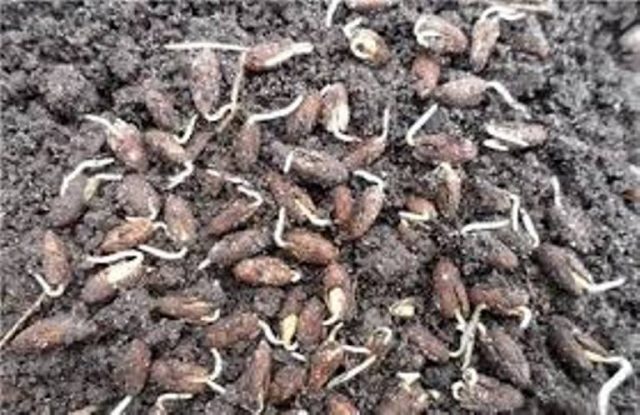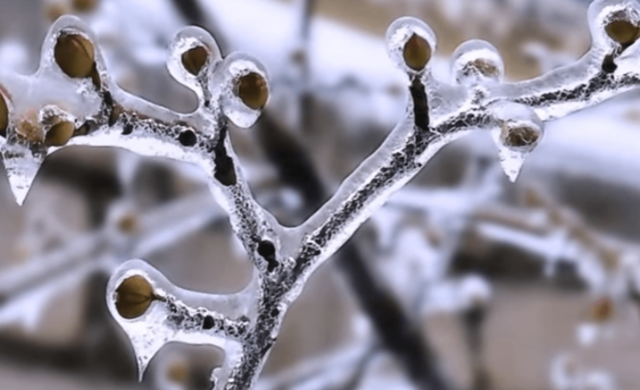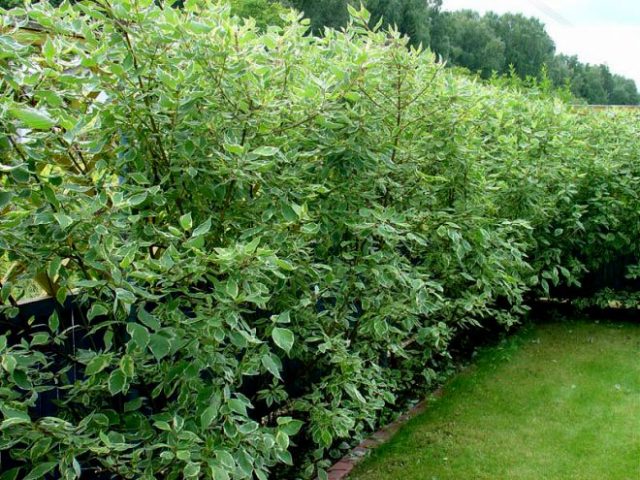Content
Cornelian cherry is a paradoxical plant. It is unpretentious and able to grow on any soil, but this applies to an adult dogwood or its cuttings / root suckers. The common dogwood can be grown from seed, but at the beginning of life it is a very moody object.
Among berry bushes, this plant blooms first and ripens last. The berries look already ripe, but in fact, they take a long time to ripen. The fruits of this plant were considered medicinal. Now they are used in traditional medicine.
Dogwood: plant description
Medium-sized deciduous plant from the sparse dogwood family. The second name of the dogwood is male dogwood. The deren root system is located near the surface of the earth, fibrous. The leaves are large, 3.5-8 cm long. The location on the branch is opposite. The shape of the leaf is simple. The color is bright green. The leaf has 3-5 pairs of veins.
The fruit is an oval-shaped drupe of dark brown, almost black color. The berries of the common wild dogwood have relatively little pulp. It is less juicy and more dense than the fruits of cultivated forms of turf.
The fruits of the garden dogwood are very large and juicy. They can be of different shapes:
- pear-shaped;
- spherical;
- oval.
The color of the ripe berry is very dark. The more common belief is that dogwood berries are red. In fact, the collection of deren berries is carried out very early, while the fruits are still firm. Ripe berries are dark brown to almost black in color and burst easily.
The surface of the berries at the male deren is shiny, smooth. Perhaps the wrong structure of the fruit, then the berry will look lumpy. Ripe common dogwood berries in the photo below.
Depending on the variety of garden turf, the weight of the berry ranges from 2 to 6 g. The percentage of pulp to the total weight of the fruit: in the wild 68%, in the garden 88%.
The natural habitat of the common wild dogwood is the southern regions. Thickets of plants are found throughout the South-Western part of Russia. The most favorable conditions for male deer are in the mountains and foothills of the Caucasus and Crimea.
The common wild dogwood did not take root well in gardeners' summer cottages, since it is essentially an underbrush and requires forest soil for successful growth. Also, male dogwood could not be bred north of its natural habitats.
Dogwood is a tree or shrub
Botanists often like to play a trick on non-specialists, asking a question about this or that representative of the flora: is it a shrub or a tree. To the amazement of ordinary people, the tree is often a bush, and the bush is actually a tree. With an ordinary dogwood, you can also joke like that. Initially, dogwood is a shrub 3-5 meters high.But on nutrient-rich soil, the strongest shoot can grow and turn into a tree 5-6 m high.
Dogwood compatibility with other trees
Gardeners know that many trees cannot stand being close to each other. The main enemy of all fruit trees is the walnut. But other plants are not always friends. For example, a pear cannot be planted next to a sweet cherry. Due to the fact that the dogwood is still a somewhat exotic inhabitant of the garden, there is almost no data on compatibility for it.
It is guaranteed that you can plant different varieties of dogwood next to each other. Perfect compatibility. According to unverified data, it is possible to plant a young dogwood under an adult apricot. Nobody knows what will happen in the opposite situation. According to other gardeners, common dogwood can be planted under almost any fruit tree, as it even prefers shaded areas. What those trees, under which the owner planted a new plant, “think” about this is not specified.
It is very doubtful that the dogwood bush is the only one of all that can grow under a walnut. In nature, in nature, walnut and turf do not come into contact.
Dogwood frost resistance
The plant is distinguished not only by its relatively good drought resistance, but also by its high frost resistance. Cornelian cherry is able to withstand frosts down to -35 ° C, which makes it possible to grow garden varieties of male dern in the northern regions. But it will not work to grow a dogwood tree in Siberia, as there are often more severe frosts. Because of this, only the shrub form of the turf is possible. When the ground part freezes, the plant recovers, letting out shoots from the roots.
Dogwood: from flowering to ripening
In addition to the official botanical names, the common dogwood has one more thing: the shaitan berry. There is a legend about the origin of the name associated with the timing of flowering and ripening of dogwood fruits.
When Allah created the world and decided to rest, during his sleep all living beings fled to the Gardens of Eden and began to divide the plants. There was a hustle and bustle, a fight broke out. Allah did not like this, and he demanded that everyone should choose only one plant for themselves. Among those who wanted to get something useful for themselves was the shaitan. And the shaitan asked the dogwood, considering himself the most cunning. After all, the common dogwood blooms earlier than all other berry plants.
This is indeed the case. The flowering time for this plant is in April at an air temperature of 8-12 ° C. The flowers of the male deren are small, yellow. Umbellate inflorescences. The number of flowers in the umbrella is 15-25. Flowers have 4 stamens and a pistil, that is, they are bisexual. Petals 4. Flowering lasts 10-14 days. The common dogwood blooming in the photo is a specimen from the forest. Garden varieties of deren do not look so beautiful.
"Early flowering dogwood - early harvest" - thought the shaitan. The first berry is highly prized, you can get a lot of money from it. Why does the Shaitan need money, the legend is silent. He sat down under a tree to await his harvest of early berries. Summer has passed, all other fruits and berries are already ripe, and the dogwood is all green.
The shaitan decided to accelerate the ripening of the fruits (that's when this technology was born) and began to blow on the berries. The dogwood turned bright red, but remained very sour and hard. Frustrated by the failure of a super-profitable business, the shaitan told people to take this muck for themselves, and spat in annoyance. So much so that the dogwood berries turned black.
And now, in late autumn, after harvesting the entire harvest in the gardens, people went into the forest for a dogwood berry. They picked black but sweet berries and laughed at the shaitan.
In fact, the common dogwood ripens not so late. The timing of harvesting the fruits of the male deren is the end of August - September. And you can't delay harvesting, as the berries fall to the ground.
And then everything was attributed to the shaitan, since he was very offended that he gave people his berry. The next year, the shaitan managed to double the dogwood harvest. People were happy about it. But for the ripening of such a quantity of deren fruits, the sun's heat was also required twice as much. And the sun, which had given off all the heat over the summer, could not warm the earth in winter. Since then, there has been a sign that if the common dogwood is well-born, it means that the winter will be cold.
Pollination of dogwood
Although the common dogwood has bisexual flowers, pollination does not occur on one plant. To obtain a crop, common dogwood needs a pollinator. The wind acts as a pollinator for male dern at low temperatures, so it is necessary to plant at least two specimens of different varieties in the garden for cross-pollination to occur.
Cornelian cherry is a strict cross-pollinated plant, therefore, you can plant two deren bushes of the same variety, but these seedlings must be from different mother bushes. The easiest way to guarantee a crop from a plant is to plant a wild forest bush next to a garden variety of deren.
When the deren is pollinated by wind, the yield will be low. Other pollinators of common dogwood are honey bees. If available, the owner of the garden is guaranteed an annual rich harvest of deren berries.
How garden dogwood blooms
The flowering of garden varieties of male deren is the same as that of the wild ancestor. Due to the fact that summer cottages are usually protected from the cold wind and have their own microclimate, garden turf can bloom even earlier than a wild plant. In northern regions, the lawn may bloom too early and may not produce fruit as a result.
When dogwood is harvested
Cultivated common dogwood can be not only of different colors and shapes, but also have early, mid and late ripening varieties. The early varieties of male deren begin to bear fruit in the second half of August, the later ones in mid-October. Therefore, the timing of harvesting berries from male deren bushes in the garden can stretch for 2 months, if you choose the varieties correctly.
The common dogwood ripens not very amicably and among the ripe berries there are unripe berries. When harvesting berries "for yourself" you will have to pick the same plant several times.
The yield of male turf depends on age.
Age, g | Productivity, kg |
5—10 | 8—25 |
15—20 | 40—60 |
25—40 | 80—100 |
How to propagate dogwood
Common dogwood propagation occurs in 5 ways:
- seeds;
- vaccination;
- cuttings;
- layering;
- basal offspring.
The first method is the most time consuming and unreliable. The second fastest in terms of obtaining berries from a newly planted plant. The other 3 require a minimum of gardening skills.
Seed propagation
This is the easiest way to grow male dogwood if the fruits were still green. The seeds are buried directly with the pulp in the ground, watered well and hope that in a few years the shell will rot and the bone will germinate.
The use of ripe deren berries implies some procedures that require a certain skill and accuracy, but allowing to accelerate the germination of the common dogwood. And all the same, the process of growing male turf will take several years:
- ripe fruits are poured with warm water and left for several days to ferment;
- after a few days, bones are taken out of the softened pulp, washed with water and placed in sawdust in a cold place (refrigerator) for 1.5 years;
- in the second year at the end of February, the seeds are taken out of the refrigerator and placed near the battery to warm up for a week;
- during the warming up, the soil is prepared for planting: one part of sand, compost and fertile soil (preferably forest from under the wild dogwood);
- the bones for accelerated germination must be carefully cut, and this is where hand precision and accuracy are required;
- after planting, the soil is watered, the containers are covered with foil and placed in a warm place.
When deren sprouts appear, the film is removed, and the containers are placed so as to protect them from direct sunlight.
The seedlings of male deren are planted in a permanent place after the onset of stable warm weather. And also in the shade or partial shade.
You can simply plant deren seeds in May directly into the ground to a depth of 3 cm and wait for seedlings to appear. To create more favorable conditions, the landing site is covered with a film.
Cuttings
Annual shoots are cut from the mother plant in the middle of summer. The lower leaves are removed from them by 1/3 and soaked in a stimulant for the growth of the root system for 5 hours. After that, they are planted in a shaded place. By the fall, about half of the male deren cuttings are taking root.
In the fall, cuttings are harvested from the lignified shoots of male turf, which are stored in the refrigerator until spring. In the spring, they are planted in a permanent place, having previously soaked in a root system stimulator.
Layers
The method is suitable for a bush, since it is very difficult to bend a young shoot from a tree. Doesn't require any knowledge, special skills and fertilizers.
In the spring, one-, two-year-old shoots of the male deren are bent to the ground and covered with soil. There are two ways to propagate common dogwood by layering:
- horizontal;
- arcuate.
With a horizontal shoot, the plants are completely covered with soil. With an arcuate, soil sprinkle only the middle of the layer, leaving the top outside. The procedure is carried out in the spring. By the fall, the shoots of the deren take root and they can be separated from the mother plant and planted in a permanent place.
The difference between these methods is that many small seedlings can be obtained from horizontal layering, since the common dogwood takes root from each pair of buds. One "goes" to the roots, and the steam room gives a sprout.
With the arcuate method, only one seedling is obtained from each layer of deren. But this seedling will be older and yield earlier.
Vaccination
Suitable for the region where the common dogwood grows. It is used if you need to quickly grow a garden variety of male deren. With this method of reproduction, only a tree is obtained, since all "wild" shoots of the male dern must be cut off annually. In this case, a standard plant is formed.
Budding is carried out in the autumn, since the spring grafting in the common dogwood takes root poorly. The budding technique is the same as for other plants. If everything is done correctly, the leaf petiole will fall off only after 3-4 days. After 1.5 months, the harness is removed. In the spring, all new wild shoots are pruned at the grafted dogwood, leaving only the grafted one.
Planting and caring for dogwood outdoors
Cornelian cherry belongs to plants that prefer to grow in open ground, since its root system, although it does not go deep into the ground, but grows widely near the surface.
Planting and caring for common dogwood is almost the same as for other fruit plants. The bush is looked after as a shrub form. Saplings are planted, making sure that the root system of the deer is preserved as best as possible. The more small roots the seedling has, the better the male turf will take root and yield earlier.
But if caring for an already established plant is not difficult, then planting is a very crucial moment, since at this time the common dogwood is very vulnerable to external factors and water shortage.
Where to plant dogwood
For planting, select a site in partial shade. Wild dogwood can grow in direct sunlight, but prefers shaded areas.For young shoots of male deren, grown from seeds, the sun's rays are contraindicated.
The site is chosen in the southwest. Preferably with a slight slope of 5-10 ° to drain excess rainwater. Groundwater should be at a depth of 1.5-2 m.
Several bushes are needed and the planting area of this plant should be large. Average indicators for one bush - 6x6 m.On rich soils with irrigation, the feeding area for one plant can be 5x4 m.For poor soils without irrigation - 7x7 m.
What kind of soil does dogwood like
Cornelian cherries require light soils with good water permeability. Sandy loam soil is well suited. If you focus on natural conditions, then you need a soil with a large amount of semi-rotten plant residues, which pass water well and supply the bushes with nutrients.
How to plant a dogwood
Having found a suitable site, a hole is dug under the seedling, 0.6 m deep. The plants are quite small, but the hole is needed to fill it with ordinary soil suitable for dogwood.
Since the plant needs a specific microflora, bacteria can multiply in the fertile soil with which the pit is filled.
When planting, the root collar is slightly deepened, since after watering the earth will settle and the collar will rise flush with the ground. After planting, the seedling is watered abundantly with water, compacting the soil. If the neck came out of the soil too high, add additional soil.
When the dogwood begins to bear fruit after planting
The fruiting time directly depends on the method of reproduction of the plant. When growing from seeds, the first harvest must be expected no earlier than 8 years after the emergence of sprouts. In the first years, the development of the root system takes place and young shoots are not up to fruiting.
A grafted tree can give its first berries the next year after planting, but the harvest will be small.
With vegetative propagation by offspring, it all depends on how old the seedling is. The harvest can be both next year and after 3-4 years. When propagated by cuttings, the harvest will be after 3-4 years.
Dogwood transplant
Since the common dogwood grows only in the open air and lives for 150 years, the best option would be to plant it in a permanent place where it will not interfere with other plants for a long time. And leave it alone. But if there is a serious need to transplant the plant, then it should be dug out with a large clod of earth in order to damage the root system as little as possible. The plant is large and you will have to use a winch or crane to transfer it to a new place.
The dug out plant is carefully transferred into a newly prepared hole and covered with new soil, observing the same precautions as when planting young seedlings. A transplant is carried out in the fall, when the plant goes into hibernation.
How to care for dogwood
Caring for an established plant consists in timely removal weeds, loosening the soil and feeding the plant in case of need.
With young and immature sprouts, there are more worries. Before wintering, the soil under the seedlings of the first year is mulched to protect the roots from freezing. Later, after the plants go into hibernation, they are covered with spruce branches. In the spring, the insulation is removed in stages. First, the seedlings are freed from spruce branches. Mulch can not be removed, but when loosening it, mix it with the ground.
Natural materials are used for mulching:
- sawdust;
- fallen leaves;
- grass;
- peat.
Organic matter, rotting, will provide the common dogwood with nutrients.
How to feed dogwood
Cornelian cherry has adapted to grow on rather poor soil. On the one hand, the territories close to the seas are not rich in nutrients. These substances simply have nowhere to come from where the sea was relatively recently.But these same areas are rich in calcium deposits. Although the common dogwood is a forest shrub, the forest litter is of little nutritional value if it has not already turned into black soil.
In summer cottages, fallen leaves are removed in order to avoid contamination of plants with pathogenic microflora. No matter how scarce the soil on which the common wild dogwood grows normally, it will lack nutrients at the dacha. Therefore, in the spring and autumn, fertilizers are applied to the soil around the plant. Although in small quantities:
- phosphoric at 30 g per sq. m in the fall;
- potash at 12 g per square meter and nitrogen at 18 g per square meter in the fall.
Organic matter is added at the rate of 2-3 kg per square meter. m.The soil is dug to a depth of 10 cm.
How to water dogwood
Young seedlings are watered relatively often in the first year, since after transplanting the bushes often suffer from a lack of moisture. An established adult plant usually does not need watering, with the exception of a particularly dry and hot summer.
How to prune dogwood
In a grafted dogwood seedling, crown formation is carried out in the first few years of life. The stem is made about 70 cm in height, leaving 5-7 main branches. Shoots at the bottom are completely cut off. Later, only sanitary pruning of the crown is carried out, removing damaged and dry branches, as well as excess branches thickening the crown.
The shrub is thinned out as needed. Ordinary planned pruning of dogwood is carried out in the fall, after the beginning of the dormant period. Also, after 20 years, the berry is rejuvenated. But even here, in order to properly cut the common dogwood for rejuvenation, it is enough just to cut off the 4-year-old shoots. In this case, many new shoots are formed.
To maintain a decorative look, pruning will have to be carried out every year, without worrying about the harvest.
Nuances of growing dogwood in the regions
If the cultivation and care of common dogwood in its habitat does not present any particular difficulties, then with more northern regions it is not so simple. Garden varieties are now grown even in the St. Petersburg region, and there it is not enough just to plant a dogwood seedling and take care of it. In other regions, not only the climate does not correspond to the usual for the common dogwood, but the soil often lacks the necessary microelements.
In central Russia
Planting and caring for dogwood in the Middle Lane differs from the southern regions in that on this territory you need to choose a sunny place, not blown by the winds and well warmed up by the sun. But even in this case, the bush does not grow higher than 1.5 m and usually does not bear fruit. The latter is due to too early flowering.
The common dogwood has a defense mechanism: when the temperature drops, the flowers fold back into buds. But this only works with small and short frosts. In addition, pollinating bees do not fly at this time.
A photo of how the common dogwood blooms during frosts with icing of the branches.
In outskirts of Moscow
There are no special varieties for the Moscow region. To grow dogwood in the Moscow region, you can use frost-resistant varieties of common dogwood bred in Ukraine, applying the agricultural technology of the Middle Lane to them:
- Eugene;
- Coral Brand;
- Nikolka;
- Vladimirsky;
- Grenadier;
- Helena;
- Lukyanovsky.
You can go a long way and put your life on breeding your own version of the hardy dogwood.
To do this, it is enough to grow several generations of dogwood bushes from seeds. The first generation is grown from purchased seed, the next will be homegrown. In several generations, it will be possible to obtain copies that will not be afraid of frosts near Moscow. And such copies already exist.Such a male dogwood was raised by a resident of Moscow region Nikolaev Vladimir Vasilyevich - an experienced gardener, carried away by the issue of adaptation of the common dogwood in the north. The flower buds of the dogwood near Moscow bloom 10-20 days later than in the southern ancestor.
In the Leningrad region
The Leningrad region is distinguished by an excess of groundwater, and the common dogwood does not tolerate waterlogging. When planting dogwood in the Leningrad region, first, a well-drained area is equipped, in which water will not linger.
The second feature of agricultural technology: providing in spring daylight hours, which will be longer than natural. Otherwise, flower buds may not bloom. The probability of getting a harvest is very low due to the absence of bees at this time.
The rest of the agricultural technology in the Leningrad region is the same as in the Central lane.
In the Urals
Due to the harsh winters for the southern bush, the common dogwood can freeze out. Even if the roots survive the winter, new shoots will not yield a harvest. Therefore, the turf in the Urals must be covered for the winter.
Even if the bush does not grow higher than 1-1.5 m, these are already long enough lashes for shelter in winter. And the tree, in general, will be impossible to close.
Close the dogwood for the winter, bending the shoots to the ground. Then they are covered with any heat-retaining material, since before a stable snow cover, the soil in an open space can be even colder than the air. In order to save space, the bushes are bent to one side, although with sufficient areas it is possible to expand the shoots even in a circle. It is difficult to bend old lignified trunks, so such branches are periodically pruned, leaving younger and more flexible shoots.
Just like the middle zone of Russia, the Ural land is poor in surface deposits of calcium. Before planting seedlings and subsequently in the soil where the dogwood grows, it is necessary to periodically add lime. In this area, common dogwood is planted only on the southern, southeastern and southwestern slopes, which are well illuminated by the sun. Unlike the southern regions, in the Urals, turf does not grow in shaded areas.
In Siberia
Planting and caring for dogwood in Siberia is carried out in the same way as in the Urals, but frost-resistant garden varieties are chosen for breeding:
- Elegant;
- Pink;
- Vavilovets;
- Glowworm;
- Joy.
Since it takes 2 years for seeds to germinate, it is better to plant dogwood with seedlings.
Why dogwood does not bear fruit
The common dogwood does not bear fruit for many reasons:
- the planted bushes are clones, that is, they come from one mother plant;
- absence of pollinating bees during flowering;
- lack of nutrients in the soil (very rarely happens);
- waterlogging;
- overdrying of soil
- insufficient vegetative period.
If the summer is dry, then you cannot be zealous with fertilizers. Due to the lack of water in the soil, the concentration of salts there is already increased. Additionally, fertilization will provoke the "suction" of moisture from the roots, which will only exacerbate the problem.
Dogwood diseases
It is believed that male dogwood is not susceptible to disease. At least in the northern regions. In fact, there are no living organisms that are not susceptible to certain diseases. Fungal diseases and pests in the common dogwood are the same as in other fruit trees.
Fungal diseases affecting male derain:
- scab (Vеntura cerasi);
- fruit rot (Monilia fructigena). More often affects fruits during long-term storage;
- powdery mildew (Erysiphales);
- leaf spot caused by three types of fungi: Ascochuta cornicola, Cercospora cornicola, Septoria cornicola;
- brown fringed spot (Ramularia angustissima);
- dark brown spot (Fusicladium pyracanthae);
- rot on fruits (Colletotrichum corni);
- rust (fungus Fungosporangium chavarieformae).
Below in the photo is what rust looks like on a sheet of male turf.
Methods for controlling fungi are common for all plants: spraying the leaves with fungicides.
In addition to fungi, the plant can infect such a large organism as the false tinder fungus (Fomes igniarius), which causes rotting of healthy parts of the plant. The only way to get rid of a tinder fungus is to completely cut down all infected plants and burn them. Since the male dogwood can grow from the root, all root systems of the affected plants will also have to be removed.
From insects of the male deren plant they eat:
- snail scale;
- micro-moth;
- multicolor caterpillar.
Ordinary methods of exterminating insect pests in gardens will protect male turf from them. Insects are natural enemies of the common dogwood and may indeed not be found in the northern regions.
The leaves of the common dogwood curl not because of illness, but from drought and on hot days. If by the evening the foliage of the male deren has turned around, then everything is in order. If not, the plant needs to be watered.
Conclusion
The common dogwood in the northern regions is a very beautiful ornamental plant, even if it is impossible to get a harvest from it. To the south of the male turf is not only decoration of the garden, but also the opportunity to get tasty healthy berries. Taking into account the modern variety of berries, the dogwood plantation will also look very elegant.

